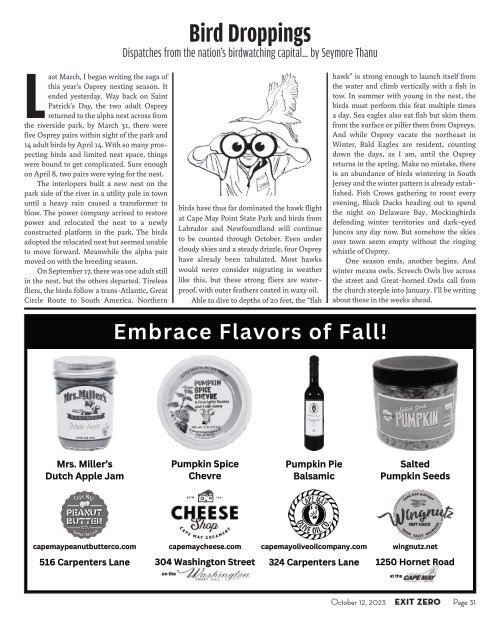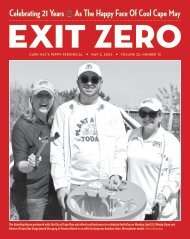V21 N36
V21, N36 October 12, 2023
V21, N36
October 12, 2023
Create successful ePaper yourself
Turn your PDF publications into a flip-book with our unique Google optimized e-Paper software.
Bird Droppings<br />
Dispatches from the nation’s birdwatching capital… by Seymore Thanu<br />
Last March, I began writing the saga of<br />
this year’s Osprey nesting season. It<br />
ended yesterday. Way back on Saint<br />
Patrick’s Day, the two adult Osprey<br />
returned to the alpha nest across from<br />
the riverside park, by March 31, there were<br />
five Osprey pairs within sight of the park and<br />
14 adult birds by April 14. With so many prospecting<br />
birds and limited nest space, things<br />
were bound to get complicated. Sure enough<br />
on April 8, two pairs were vying for the nest.<br />
The interlopers built a new nest on the<br />
park side of the river in a utility pole in town<br />
until a heavy rain caused a transformer to<br />
blow. The power company arrived to restore<br />
power and relocated the nest to a newly<br />
constructed platform in the park. The birds<br />
adopted the relocated nest but seemed unable<br />
to move forward. Meanwhile the alpha pair<br />
moved on with the breeding season.<br />
On September 17, there was one adult still<br />
in the nest, but the others departed. Tireless<br />
fliers, the birds follow a trans-Atlantic, Great<br />
Circle Route to South America. Northern<br />
birds have thus far dominated the hawk flight<br />
at Cape May Point State Park and birds from<br />
Labrador and Newfoundland will continue<br />
to be counted through October. Even under<br />
cloudy skies and a steady drizzle, four Osprey<br />
have already been tabulated. Most hawks<br />
would never consider migrating in weather<br />
like this, but these strong fliers are waterproof,<br />
with outer feathers coated in waxy oil.<br />
Able to dive to depths of 20 feet, the “fish<br />
hawk” is strong enough to launch itself from<br />
the water and climb vertically with a fish in<br />
tow. In summer with young in the nest, the<br />
birds must perform this feat multiple times<br />
a day. Sea eagles also eat fish but skim them<br />
from the surface or pilfer them from Ospreys.<br />
And while Osprey vacate the northeast in<br />
Winter, Bald Eagles are resident, counting<br />
down the days, as I am, until the Osprey<br />
returns in the spring. Make no mistake, there<br />
is an abundance of birds wintering in South<br />
Jersey and the winter pattern is already established.<br />
Fish Crows gathering to roost every<br />
evening, Black Ducks heading out to spend<br />
the night on Delaware Bay. Mockingbirds<br />
defending winter territories and dark-eyed<br />
Juncos any day now. But somehow the skies<br />
over town seem empty without the ringing<br />
whistle of Osprey.<br />
One season ends, another begins. And<br />
winter means owls. Screech Owls live across<br />
the street and Great-horned Owls call from<br />
the church steeple into January. I’ll be writing<br />
about these in the weeks ahead.<br />
Embrace Flavors of Fall!<br />
Mrs. Miller’s<br />
Dutch Apple Jam<br />
Pumpkin Spice<br />
Chevre<br />
Pumpkin Pie<br />
Balsamic<br />
Salted<br />
Pumpkin Seeds<br />
capemaypeanutbutterco.com capemaycheese.com capemayoliveoilcompany.com wingnutz.net<br />
516 Carpenters Lane 304 Washington Street 324 Carpenters Lane 1250 Hornet Road<br />
on the<br />
at the<br />
October 12, 2023 EXIT ZERO Page 31


















